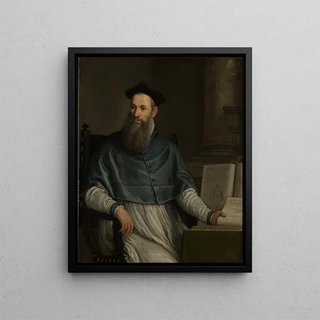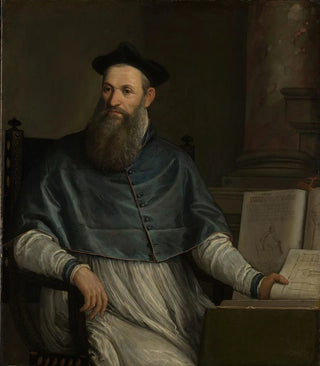Art print | Portrait of Daniele Barbaro - Paolo Veronese


View from behind

Frame (optional)
Art print Portrait of Daniele Barbaro - Paolo Véronèse – Captivating Introduction
The "Portrait of Daniele Barbaro" by Paolo Véronèse is an iconic work that transcends the simple framework of a portrait to become part of the rich and complex history of the Italian Renaissance. This painting, created in the 16th century, not only demonstrates Véronèse's technical virtuosity but also highlights the importance of the intellectual figures of his time. Daniele Barbaro, humanist and architect, is depicted here in a posture that evokes both dignity and depth of thought. This art print is not limited to a physical representation; it invites the viewer to delve into the intellectual universe of its subject, thus revealing the deep connections between art, science, and philosophy of the Renaissance.
Style and uniqueness of the work
The stylistic richness of the "Portrait of Daniele Barbaro" is undeniable. Véronèse, master of chiaroscuro and color, employs a vibrant palette that gives his subject an almost tangible presence. The drapery of Barbaro's clothing, carefully rendered, seems to capture light in a way that emphasizes texture and depth. The composition is skillfully balanced, with elements guiding the viewer’s gaze toward the expressive face of the humanist. The latter, captured in a moment of reflection, embodies the quintessence of the Renaissance spirit, where the individual is both a thinker and an active participant in the world. Véronèse’s play with shadows and light creates an almost theatrical atmosphere, enhancing the unique character of this work which, beyond a simple representation, tells a story.
The artist and his influence
Paolo Véronèse, whose real name is Paolo Caliari, is one of the greatest painters of the Venetian Renaissance. His flamboyant style and ability to incorporate narrative elements into his works marked his era and continue to influence contemporary artists. Véronèse successfully combined influences from Titian and Tintoretto, while developing a personal signature that is uniquely his own. His work on portraits, especially those of intellectual figures like Daniele Barbaro, reflects his interest in themes of knowledge and culture. By celebrating the

Matte finish

View from behind

Frame (optional)
Art print Portrait of Daniele Barbaro - Paolo Véronèse – Captivating Introduction
The "Portrait of Daniele Barbaro" by Paolo Véronèse is an iconic work that transcends the simple framework of a portrait to become part of the rich and complex history of the Italian Renaissance. This painting, created in the 16th century, not only demonstrates Véronèse's technical virtuosity but also highlights the importance of the intellectual figures of his time. Daniele Barbaro, humanist and architect, is depicted here in a posture that evokes both dignity and depth of thought. This art print is not limited to a physical representation; it invites the viewer to delve into the intellectual universe of its subject, thus revealing the deep connections between art, science, and philosophy of the Renaissance.
Style and uniqueness of the work
The stylistic richness of the "Portrait of Daniele Barbaro" is undeniable. Véronèse, master of chiaroscuro and color, employs a vibrant palette that gives his subject an almost tangible presence. The drapery of Barbaro's clothing, carefully rendered, seems to capture light in a way that emphasizes texture and depth. The composition is skillfully balanced, with elements guiding the viewer’s gaze toward the expressive face of the humanist. The latter, captured in a moment of reflection, embodies the quintessence of the Renaissance spirit, where the individual is both a thinker and an active participant in the world. Véronèse’s play with shadows and light creates an almost theatrical atmosphere, enhancing the unique character of this work which, beyond a simple representation, tells a story.
The artist and his influence
Paolo Véronèse, whose real name is Paolo Caliari, is one of the greatest painters of the Venetian Renaissance. His flamboyant style and ability to incorporate narrative elements into his works marked his era and continue to influence contemporary artists. Véronèse successfully combined influences from Titian and Tintoretto, while developing a personal signature that is uniquely his own. His work on portraits, especially those of intellectual figures like Daniele Barbaro, reflects his interest in themes of knowledge and culture. By celebrating the






